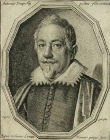Antonio Tempesta (1555-1630)
Antonio Tempesta (1555-1630)  Italian painter and engraver, a point of connection between Baroque Rome and the culture of Antwerp.He was born and trained in Florence and painted in a variety of styles, influenced to some degree by "Contra-Maniera" or counter-Mannerism. He enrolled in the Florentine Accademia del Disegno in 1576, and was a pupil of Santi di Tito, then of the Flemish painter Joannes Stradanus. He is now best known as a printmaker in etching and engraving.
Italian painter and engraver, a point of connection between Baroque Rome and the culture of Antwerp.He was born and trained in Florence and painted in a variety of styles, influenced to some degree by "Contra-Maniera" or counter-Mannerism. He enrolled in the Florentine Accademia del Disegno in 1576, and was a pupil of Santi di Tito, then of the Flemish painter Joannes Stradanus. He is now best known as a printmaker in etching and engraving.
He was part of the large set of artists working under Giorgio Vasari on the interior decoration of the Palazzo Vecchio.
His favorite subjects were battles, cavalcades, and processions. He relocated to Rome, where he associated with artists from the Netherlands, which may have led to his facility with landscape painting.
He and Mattheus Brill were commissioned by Pope Gregory XIII to paint wide panoramas of the Procession to Transfer the Relics of St Gregory of Nazianzus (1572) for the loggias on the third floor of the Vatican Palace. He completed frescoes in the Palazzina Gambara at the Villa Lante in Bagnaia (1578-09). From 1579-1583, Tempesta participated in the decoration of the Villa Farnese in Caprarola, notably of this villa's Scala Regia. He is also known to have collaborated on frescoes in the Villa d'Este at Tivoli and the Palazzina Gamara at Villa Lante, Bagnaia He painted series of turbulent and crowded battle scenes for the Medici. He also completed a series of engravings on outdoor courtly hunting scenes. He illustrated many books, including editions of Ovid. He also painted frescoes for the Palazzos Colonna, the Doria Pamphilj, and for the Marchese Giustiniani in his Roman palace, where Tempesta collaborated with Paul Bril and at Bassano Sutri. He also drew many designs for tapestries. He painted a Murder of the Innocents for the church of Santo Stefano Rotondo in Rome.
He also left numerous etchings, among them: Plates from the Old Testament; twenty-four plates from the Life of St. Anthony; a set of one hundred and fifty prints from Ovid’s Metamorphoses; thirteen plates on The Labors of Hercules; four plates on The Ages of Man; The Entry of Alexander into Babylon; Diana and Actaon, and The Crucifixion (1612).
Antonio, perhaps even more then Rembrandt saw the etching technique as the medium to express his art. He made a larger amount of them and specialized in the study of horses who are, in his oeuvre of an exceptional quality.
There are no products matching the selection.






 Facebook
Facebook Twitter
Twitter Subscribe us
Subscribe us Flickr
Flickr




